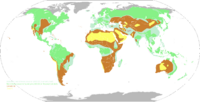

Animal husbandry is a form of agriculture in which livestock is bred and raised. The livestock is then eaten, or used for milk or eggs. Sometimes additional products can be attained such as leather, and the animal can also be used as a draft animal or used for transport. Although animal husbandry has several negative effects (see below), some areas naturally have (or had) open grasslands and are are not the native region of specific (plant-based) protein-foods (ie tofu, ...). Due to this, in these circumstances, growing animals may be appropriate. It however should be used only as a last resort.
In the map on the right, you can notice the appropriate locations were this can be done. The animals should be fed only with grass, the growing of other crops (ie maize, soy, grain, ...) would make the approach unappropriate and highly inefficient (these other -imported- crops would then be best eaten by the person itself). Note that one of the main reasons why the growing of animals can be appropriate in some situations at all is simply due to the presence of protein in the meat, calories can often be attained from other plants that can be grown in the region.
The other map on the right shows the native animal species that can be used per region.
Note that cattle is discarded alltogether/not included in the list since it isn't a native animal anywhere (it is a species crossed by the human population, from the aurochs -itself now extinct-). the same is true for the zebu. Animals such as pheasants (which do not much plants, but rather berries, nuts, grain) are also not included in the list. The wild turkey also eats nuts, berries, grasses (it's an omnivore) but still consumes allot of grasses aswell.
The ancestor of the domestic pig, or rather the wild boar (Sus scrofa) is also not included in the list because, although it does consume grass aswell (actually omnivore), the many different subspecies (Sus scrofa scrofa or the european wild boar, Sus scrofa cristatus: (indian), Sus scrofa leucomystax (eastern), Sus scrofa vittatus (malaysian, Northern and Central Europe, the Mediterranean Region (including North Africa's Atlas Mountains) and much of Asia as far south as Indonesia) would lead us too far, and too much text would need to be placed on the map. .
Also note that many other animals can be added, ie: deer, antelopes, the European rabbit (Oryctolagus cuniculus), cottontail rabbit (genus Sylvilagus; 13 species), and the Amami rabbit.
Pros and cons of animal husbandry
- creates huge methane emissions (90 millon tons worldwide, appearantly 510 million tons is sufficient to kill everyone on the planet, ie due to climate change)
- can transfer disease, unappealing practice of slaughtering
- wasteful method (energy is lost in conversion of grass to meat)
- very labour-intensive and (depending on what it's compared against, low-yield) method of protein production
- can disrupt the local ecosystem by taking up allot of space and prventing the housing of other animal and plant species
- ethical considerations by certain individuals
Specific issues
Regarding labour intensity: Note that cattle farms are always very labour intensive, as they generally feed with grain, ... (not grass). That is however if you include the work for the growing the feed.
Although due to the increased use of machinery (ie harvesters), allot less people are required to grow grain, grain still requires allot of processing (cutting, beating/dehusking, may require pesticide use, water, ... ) So it is nevertheless very energy intensive, labour intensive (though not human labour intensive) Regardless, what I mostly mean is that a additional crop is often grown to feed the animal at all, and this should be prevented. If the animal is only fed with grass (which is a crop humans can't digest), the issue is completely eliminated.
Also note that by growing wild animal species, it allows the the animals to be be released into the wild once we no longer need them (once suitable crops are found for the region), hence allowing the discarding of the use of animals.
Slaughtering and processing
The animal needs to be slaughtered and processed in such a way that most of the animal can be used. There is always a degree of waste (unusable animal parts), and not all animal parts are as healthy/tasty. See Butchering a Beef (Bittersweet, Volume VII, No. 1, Fall 1979)
See also
External links
- http://en.wikipedia.org/wiki/List_of_domesticated_meat_animals
- http://en.wikipedia.org/wiki/Ungulates
- http://en.wikipedia.org/wiki/Beef_cattle
- http://en.wikipedia.org/wiki/Cattle
- http://en.wikipedia.org/wiki/Bovinae
- How to Direct Market Your Beef - Download this 96 page book free as a PDF file.
- How to Direct Market Your Beef" portrays how one couple used their family's ranch to launch a profitable, grass-based beef operation focused on direct market sales.